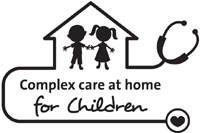Indications:
- Non-invasive ventilation with a mask helps the child without a tracheostomy to breathe better by mechanically pushing air and oxygen (O2) into the lungs (inspiration) and facilitating the release of carbon dioxide (CO2) in exhaled air (expiration). Ventilatory assistance supports the child’s life and improves the child’s ability to do activities and to develop.
- Below is a suggested method that can serve as a guide; discuss the specific type of medical supplies and equipment used for your child with the healthcare team.
Considerations:
- If your child requires medications during the time that non-invasive ventilation is being used, refer to your healthcare team to learn the techniques for correct administration.
- Non-invasive ventilation may be interrupted if your child requires aspiration of secretions; refer to your child’s healthcare team to learn how to do this correctly.
- Evaluate the need for a second person to help keep your child in a safe position during the procedure (eg, your child is young or moving around a lot).
- Good handwashing is essential before and after providing care.
- Ensure the comfort of your child during care by using different positioning and distraction techniques.
Frequency:
- Your child may require non-invasive ventilation with a mask episodically, only at night or at all times, depending upon your child’s condition.
- The need for non-invasive ventilatory assistance may increase during respiratory infections.
- Verify the recommended frequency of non-invasive ventilation with your child’s healthcare team.
Required materials:
The method of care below is illustrated using a nasal mask and a bi-level BiPAP® device A-30 or A-40.
Refer to your child’s healthcare team if the material or the sequence of steps you have been taught is different than those described here.








